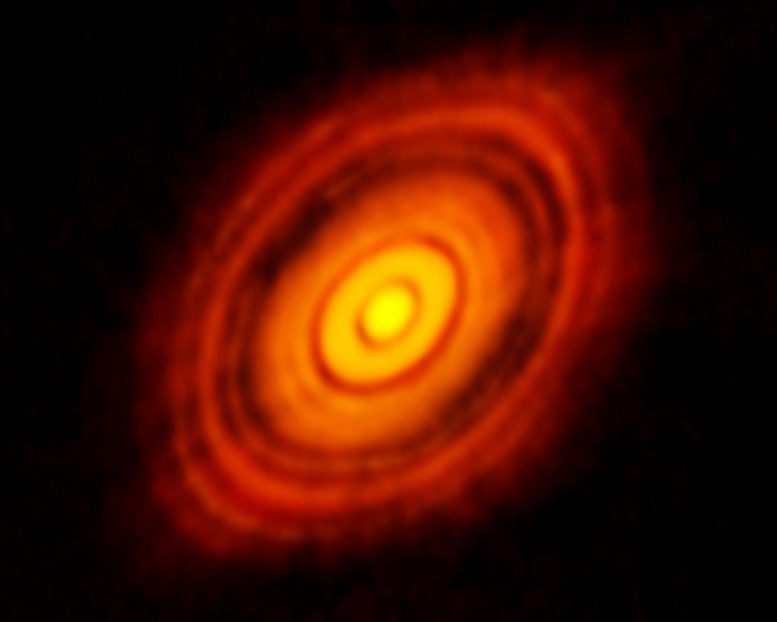A 21-cm view of the Pinwheel Galaxy (M33). The rainbow of colors is due to the rotation of the galaxy, which Doppler-shifts the radio light. Credit: NRAO/AUI/NSF
Radio light comes in a rainbow of colors. We see these colors with radio bands, and each band has a story to tell about the universe.
Radio astronomers view the universe in several ranges of wavelengths we call bands. The Very Large Array (VLA) uses wavelengths ranging from 4 meters to less than a centimeter. The Atacama Large Millimeter/submillimeter Array (ALMA) uses radio bands ranging from a couple of centimeters to a third of a millimeter. But why do radio telescopes use such a wide range of wavelengths? The answer lies in the many ways that objects emit radio light, and how this light interacts with the gas and dust of interstellar space.
Long radio wavelengths, such as those seen by the VLA’s Band 4, are typically produced by ionized gas. It lets us see where hot plasma is located in our galaxy. These long wavelengths are also useful because most neutral gas is transparent at these wavelengths. This means very little of this light is absorbed as it travels through space. Shorter wavelengths of light are often emitted by particular atoms or molecules. One of the most important of these is the 21-centimeter line, which is emitted by neutral hydrogen. This wavelength is one of the best ways to observe the distribution of matter in a galaxy since hydrogen is by far the most abundant element in the universe.
Wavelengths in the 10-cm to 20-cm range are particularly good for radio sky surveys, such as the VLA Sky Survey (VLASS). Radio galaxies are particularly bright in this range as are the jets emitted by supermassive black holes. By scanning the sky at these wavelengths, VLASS has captured images of nearly 10 million radio sources.
Light with wavelengths of a centimeter or two is often emitted through a process known as synchrotron radiation. When electrons speed through a strong magnetic field, the magnetic field forces them to move in tight spirals along the magnetic field lines. Because of this, they emit radio light. Synchrotron radiation is particularly useful at mapping the magnetic fields near black holes. Another process that emits light in this range is known as a maser or microwave laser. We’re most familiar with simple laser pointers that emit coherent red light, but in interstellar space pockets of water can emit coherent light with a wavelength of 1.3 centimeters. Since these water masers emit a very specific wavelength of light, they can be used to measure the rate at which the universe expands.
Radio wavelengths on the order of a millimeter are particularly useful for studying cold gas and dust. Dust grains in interstellar space emit light with wavelengths on the order of their size, and since much of this dust is about a millimeter in size, that’s the wavelength where they emit the most light. These short wavelengths can be difficult to observe, in part because our atmosphere absorbs much of the light at these wavelengths. But they are also vitally important for the study of young planetary systems. ALMA has been able to capture disks of gas and dust around young stars and has even seen how gaps form within these disks as young planets begin to form. It is revolutionizing our understanding of how exoplanets form.

ALMA Observatory image of the young star HL Tau and its protoplanetary disk. One of the best images ever of planet formation, this image reveals multiple rings and gaps that herald the presence of emerging planets as they sweep their orbits clear of dust and gas. Credit: ALMA(ESO/NAOJ/NRAO); C. Brogan, B. Saxton (NRAO/AUI/NSF)
But perhaps one of the more interesting radio bands is ALMA’s Band 6, which captures light with wavelengths from 1.1 – 1.4 mm. It has been used to study how red giant stars generate heat, and the distribution of molecules in planetary nebulae. But it was also used to create one of the most powerful radio images of recent years, that of the supermassive black hole in the heart of galaxy M87. Band 6 receivers were used on radio telescopes across the world as part of the Event Horizon Telescope (EHT), and the data they gathered was combined to create the first direct image of a black hole.
Radio light is invisible to our eyes, so it’s easy to think of all radio light as the same. But radio is filled with colors, just as the colors of visible light we can see, and radio astronomy is at its most powerful when we use all the colors of its rainbow.







